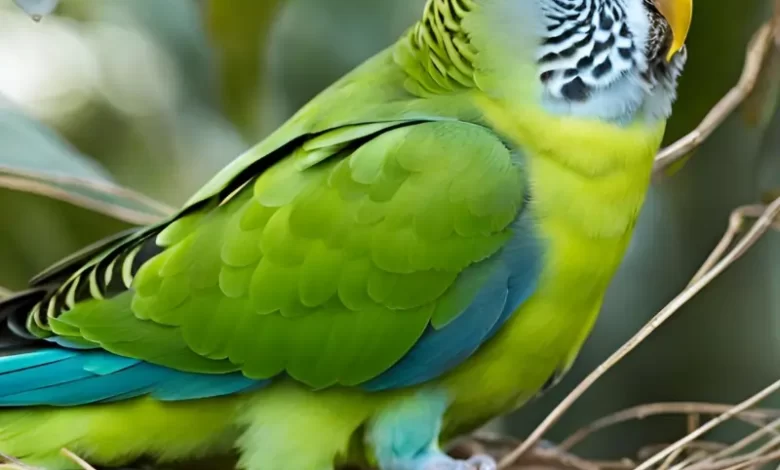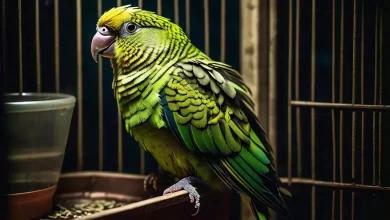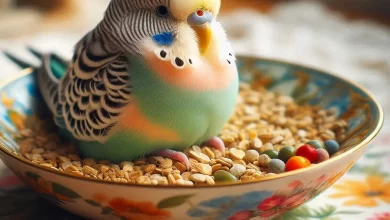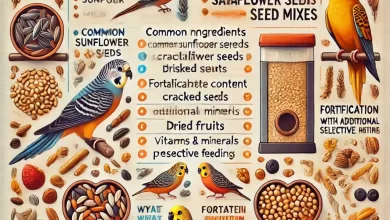How Often Do Parakeets Lay Eggs? A Complete Guide to Parakeet Breeding Cycles

As we delve into this topic, we’ll address common concerns and questions, such as whether parakeets lay eggs year-round and how their egg-laying habits compare to other pet birds like cockatiels. We’ll also explore the differences between wild and domesticated parakeet breeding patterns, giving you a well-rounded understanding of these fascinating creatures.
So, if you’re ready to become an expert on parakeet egg-laying and breeding cycles, read on. This guide will equip you with the knowledge to provide the best care for your feathered friends during this critical aspect of their lives.
Parakeet Breeding Basics
Sexual Maturity in Parakeets
Like other birds, parakeets must reach sexual maturity before they can reproduce. On average, these colorful budgerigars become sexually mature between 3 to 6 months of age. However, it’s important to note that just because a parakeet can breed doesn’t mean it should. Many experienced breeders recommend waiting until parakeets are at least 10 to 12 months old before allowing them to breed, ensuring they are physically and emotionally prepared for the demands of reproduction.
Natural Breeding Seasons
Parakeets typically have specific breeding seasons in the wild influenced by environmental factors. These seasons usually coincide with periods of abundant food and favorable weather conditions. The phenomenon known as photoperiodic breeding response plays a crucial role in this process. This biological mechanism causes hormonal changes in parakeets based on the length of daylight, signaling the ideal time for breeding.
For wild parakeets native to Australia, the breeding season often occurs during spring and early summer. However, domesticated parakeets kept as pets may not adhere strictly to these natural cycles. Indoor lighting, temperature control, and consistent food availability can alter their breeding patterns, sometimes leading to year-round breeding readiness.
Understanding these basics of parakeet breeding is crucial for responsible pet ownership and breeding practices. It helps recognize the signs of breeding readiness and ensures you can provide the best care for your feathered companions throughout their reproductive cycles.
How Often Do Parakeets Lay Eggs?
Average Frequency of Egg-Laying
A female parakeet (hen) can lay eggs every 2 to 3 days in optimal conditions. Typically, they will lay 4 to 6 eggs in a single clutch, though some may lay up to 8 or even 10 eggs in a single clutch. After laying a complete clutch, the hen takes a break before the next breeding cycle starts.
It’s important to note that parakeets don’t lay eggs year-round like chickens. Instead, they have specific breeding periods. In captivity, with ideal conditions, a healthy pair of parakeets might produce 2 to 3 clutches per year. However, allowing more frequent breeding can harm the hen’s health.
Factors Affecting Egg-Laying Frequency
Several factors can influence how often a parakeet lays eggs:
- Age: Younger hens may lay eggs more frequently than older ones. As parakeets age, their egg production typically decreases.
- Health: A parakeet’s overall health significantly impacts its ability to lay eggs. Proper nutrition, regular check-ups, and a stress-free environment are crucial for maintaining reproductive health.
- Environment: The setting in which parakeets live plays a vital role in their breeding behavior. Factors like lighting, temperature, and suitable nesting sites can affect egg-laying frequency. For instance, indoor parakeet breeding in cold regions may require special considerations to simulate natural breeding conditions.
- Diet: A balanced diet rich in calcium and other essential nutrients is crucial for egg production. Parakeet breeding supplements can help ensure that hens have the necessary resources for egg-laying.
Understanding these factors can help you better manage your parakeet’s reproductive cycles and ensure their well-being. It’s crucial to remember that while parakeets can lay eggs frequently under ideal conditions, excessive egg-laying can be harmful. As a responsible pet owner, monitoring and, if necessary, controlling breeding to maintain your parakeet’s health is essential.
The Parakeet Egg-Laying Process
Mating Behavior
Before egg-laying occurs, parakeets engage in specific courtship rituals. Male parakeets often become more vocal, singing and chattering to attract the female’s attention. They may also engage in head-bobbing, wing-flapping, and beak-tapping behaviors. The female, if receptive, will respond with similar behaviors.
You might notice changes in your parakeets’ cere color during this period. In males, the cere (the fleshy area above the beak) usually becomes a deeper blue, while in females, it may turn brown or crusty when they’re in breeding condition.
Nest Preparation
Once a pair has bonded, they will start preparing a nest. In the wild, parakeets nest in tree hollows, but in captivity, they require a nesting box. The female typically takes the lead in nest preparation, shredding materials like paper or wood to create a comfortable nesting area.
It’s crucial to provide appropriate nesting materials for your parakeets. Avoid materials that can tangle around their feet or cause impaction if ingested. Safe options include untreated wood shavings or specialized nesting material available at pet stores.
Egg Development and Laying
The process of egg development, known as oogenesis, occurs within the female parakeet’s body. Once fertilization occurs, an egg takes about 48 hours to form and be laid entirely. This process, called oviposition in parakeets, typically happens in the early morning.
Parakeets usually lay one egg every other day until their clutch is complete. A typical clutch size ranges from 4 to 6 eggs, though it can vary. After laying an egg, the hen may rest for a day before laying the next one.
It’s important to note that parakeets don’t usually start incubating their eggs until the entire clutch is laid. This ensures that all the chicks will hatch around the same time. The incubation period for parakeet eggs is typically about 18 days.
Understanding this process can help you provide the best care for your breeding parakeets and know what to expect during the egg-laying period. Remember, while it’s fascinating to observe, breeding should only be undertaken with careful consideration and preparation.
Egg-Laying Cycles in Domesticated Parakeets
Differences from Wild Parakeets
Wild parakeets typically have a more defined breeding season in their natural habitat, usually coinciding with favorable environmental conditions. Changes in daylight hours, temperature, and food availability often trigger these seasons.
Domesticated parakeets, however, may not adhere to these natural cycles. The controlled environment of a home or aviary can lead to altered breeding patterns. With consistent lighting, stable temperatures, and year-round food availability, pet parakeets might be physiologically ready to breeding patterns. With consistent lighting, stable temperatures, and year-round food availability, pet parakeets might be physiologically ready to breed anytime.
Impact of Artificial Lighting and Temperature
Artificial lighting is one of the most significant factors affecting domesticated parakeets’ breeding cycles. In the wild, the changing photoperiod (length of daylight) plays a crucial role in regulating breeding behavior. This natural cycle, known as the photoperiodic breeding response, signals to birds when conditions are suitable for reproduction.
In captivity, artificial lighting can disrupt this natural cycle. Consistent long daylight hours might trick a parakeet’s body into thinking it’s always breeding season. This can lead to year-round egg production, which isn’t natural or healthy for the birds.
Temperature also plays a role. While wild parakeets experience seasonal temperature changes, domesticated birds often live in climate-controlled environments. This constant comfort can contribute to more frequent breeding behavior.
Managing Breeding Cycles in Captivity
To maintain the health of your parakeets and mimic more natural breeding patterns, consider the following:
- Light Control: Use timers on cage lights to simulate natural daylight cycles. Gradually increase daylight hours in spring and decrease in fall.
- Temperature Variation: If possible, allow for slight temperature fluctuations in your bird’s environment to mimic seasonal changes.
- Diet Adjustments: Modify your parakeet’s diet seasonally to reflect changes in natural food availability.
- Nesting Opportunities: Only provide nesting boxes during planned breeding times to discourage constant egg-laying.
Understanding and managing these factors can help regulate your parakeet’s breeding cycles, ensuring healthier birds and more successful breeding when desired.
Health Concerns Related to Frequent Egg-Laying
While egg-laying is natural for female parakeets, excessive or frequent egg production can lead to several health issues. As a responsible pet owner, it’s crucial to be aware of these potential problems and know how to address them.
Calcium Depletion
Calcium depletion is among the most common health concerns associated with frequent egg-laying. Eggs require a significant amount of calcium to form, and if a parakeet lays eggs too often, it can deplete her body’s calcium reserves. This can lead to:
- Soft-shelled or shell-less eggs
- Weakness in bones and muscles
- Egg binding (difficulty passing eggs)
To prevent calcium depletion, ensure your parakeet has a balanced diet rich in calcium. Calcium supplementation may be necessary during breeding seasons or for frequent egg-layers. Cuttlebone, mineral blocks, and specially formulated calcium supplements for parakeets can help maintain proper calcium levels.
Exhaustion
Frequent egg-laying can be physically taxing for parakeets. Forming and laying eggs requires a lot of energy; if a hen is constantly in this cycle, it can lead to exhaustion. Signs of exhaustion may include:
- Lethargy or decreased activity
- Loss of appetite
- Ruffled feathers or unkempt appearance
It’s essential to control breeding cycles and ensure your parakeet has adequate rest periods between clutches to prevent exhaustion. A balanced diet and reducing stress in their environment can also help maintain their energy levels.
Egg Binding
Egg binding is a severe condition where a female parakeet cannot pass an egg. This can occur for various reasons, including calcium deficiency, obesity, or exhaustion from frequent laying. Symptoms of egg binding include:
- Straining or sitting on the cage floor
- Swollen abdomen
- Labored breathing
- Drooping wings
Egg binding is a medical emergency and requires immediate veterinary attention. In some cases, it can be fatal if not treated promptly.
Treating Egg Binding in Female Parakeets
If you suspect your parakeet is egg-bound:
- Keep her warm and calm
- Increase humidity in her environment
- Consult an avian veterinarian immediately
Prevention is vital when it comes to egg binding. Ensure proper nutrition, maintain a healthy weight, and avoid encouraging excessive egg-laying.
Managing these health concerns involves a combination of proper nutrition, environmental control, and careful observation of your parakeet’s behavior and physical condition. Regular check-ups with an avian veterinarian can help catch and address potential issues early.
Remember, while parakeets can lay eggs frequently, it’s not always in their best interest to do so. Monitoring and controlling breeding behavior is an essential part of responsible parakeet ownership.
Managing Parakeet Breeding
Proper parakeet breeding management is crucial for your birds’ health and well-being. This involves controlling breeding behavior, ensuring adequate nutrition, and knowing when to separate pairs. Let’s explore these aspects in detail.
Controlling Breeding Behavior
While parakeets may be ready to breed year-round in captivity, limiting their breeding for their health is essential. Here are some strategies to control breeding behavior:
- Light Manipulation: Adjust the amount of light your parakeets receive. Reducing daylight hours can discourage breeding behavior.
- Remove Nesting Sites: If you’re not planning for breeding, avoid providing nesting boxes or materials that might encourage nesting behavior.
- Rearrange the Cage: Occasional changes in the cage setup can disrupt breeding behaviors.
- Separate Pairs: Keep male and female parakeets in separate cages to prevent breeding.
Proper Nutrition for Breeding Parakeets
What to feed parakeets during breeding season is crucial for their health and the success of the breeding process. A balanced diet should include:
- High-quality seed mix or pellets formulated for breeding birds
- Fresh fruits and vegetables
- Calcium-rich foods like cuttlebone or mineral blocks
- Protein sources such as cooked egg or commercial egg food
- Fresh, clean water daily
During the breeding season, parakeets may require more food than usual. Monitor their intake and adjust accordingly. Avoid sudden diet changes, as this can stress the birds.
When to Separate Pairs
Knowing when to separate breeding pairs is an essential aspect of parakeet management. Reasons for separation might include:
- After Successful Breeding: Once chicks are weaned, separate the pair to allow the hen to rest and recover.
- Aggressive Behavior: Separation may be necessary for safety if one bird becomes overly aggressive.
- Health Issues: If one bird is ill, separate to prevent stress and potential disease transmission.
- Overbreeding: If a pair is producing too many clutches, separation can help control breeding frequency.
When separating pairs, ensure each bird has its spacious cage with plenty of enrichment activities. Gradual separation (e.g., separate cages side by side) can help reduce stress.
Remember, successful parakeet breeding management requires careful observation, proper care, and sometimes the willingness to intervene. By controlling breeding behavior, providing appropriate nutrition, and knowing when to separate pairs, you can ensure the health and well-being of your parakeets while still allowing for successful breeding when desired.
Signs of Impending Egg-Laying in Parak
Recognizing the signs that your parakeet is about to lay eggs is crucial for providing proper care and ensuring a smooth egg-laying process. These signs can be divided into behavioral and physical changes.
Behavioral Changes
As egg-laying approaches, you may notice several changes in your parakeet’s behavior:
- Increased Nesting Activity: Your parakeet may spend more time in or around the nesting box, arranging nesting materials.
- Territoriality: The female might become more protective of her chosen nesting area, sometimes showing aggression towards other birds or even humans.
- Increased Appetite: She may eat more than usual to prepare for egg production.
- Changed Vocalization: Some parakeets become quieter, while others may vocalize more frequently.
- Mating Behavior: You might observe more frequent mating attempts between the pair.
Broody behavior is a crucial indicator that your parakeet is preparing to lay eggs. This includes spending long periods in the nesting box, even when not laying, and being reluctant to leave the nest.
Physical Changes
Several physical changes can also indicate that your parakeet is preparing to lay eggs:
- Weight Gain: The female may gain weight as her body prepares for egg production.
- Swollen Abdomen: Her lower abdomen might appear slightly swollen or enlarged.
- Wider Stance: You may notice her standing with her legs farther apart than usual.
- Frequent Stretching: She might stretch more often, especially her wings and legs.
- Changes in Droppings: Her droppings may become more prominent and less frequent.
Cere Color Changes
One of the most noticeable physical changes is in the cere color. In female parakeets:
- The cere (the fleshy area above the beak) often becomes thicker and crusty.
- It may change color, typically becoming brown or tan.
- In some cases, it might develop a flaky appearance.
These cere color and texture changes are due to hormonal fluctuations associated with breeding readiness.
It’s important to note that while these signs generally indicate impending egg-laying, not all parakeets will display all of these signs, and some may show additional or different behaviors. Regular observation and familiarity with your parakeet’s normal behavior will help you notice these changes when they occur.
By recognizing these signs early, you can ensure that your parakeet has a suitable nesting environment and receives proper nutrition to support egg production. This preparedness can contribute to a healthier egg-laying process for your feathered friend.
What to Do When Your Parakeet Lays Eggs
Once you’ve recognized the signs and your parakeet has begun laying eggs, it’s essential to know how to care for the bird and the eggs properly. This section will cover providing appropriate nesting materials and egg care.
Providing Proper Nesting Materials
Creating a suitable nesting environment is crucial for your parakeet’s comfort and the safety of the eggs. Here are some key points to consider:
- Nesting Box: Provide a proper nesting box that’s spacious enough for your parakeet. For most parakeet breeds, the box should be about 12 inches x 12 inches x 12 inches.
- Location: Place the nesting box in a quiet, somewhat secluded area of the cage to reduce stress.
- Best Nesting Materials for Parakeets:
- Wood shavings (avoid cedar, which can be toxic)
- Unscented, undyed paper towels torn into strips
- Specialized bird nesting material from pet stores
- Avoid materials that can tangle or cause impaction, such as long strings or synthetic fibers
- Depth: Provide about 2 inches of nesting material at the bottom of the box.
- Regular Cleaning: Clean and replace nesting material regularly to maintain hygiene, but be cautious not to disturb the bird too much during egg-laying and incubation.
Egg Care
Proper egg care is essential for successful hatching if you plan to breed your parakeets. Here’s what you need to know:
- Handling: Minimize handling of the eggs. If necessary, wash your hands thoroughly before touching them.
- Marking: Mark eggs with a non-toxic marker to track laying order and expected hatch dates.
- Monitoring: Check eggs regularly for any cracks or abnormalities.
- Temperature and Humidity: Maintain a stable environment. The ideal temperature for parakeet eggs is around 98.6°F (37°C), with humidity between 50% and 60%.
- Turning: If the hen isn’t sitting on the eggs consistently, you may need to turn them gently 2-3 times a day to prevent the embryo from sticking to the shell.
How to Set Up a Parakeet Breeding Cage
If you’re planning for your parakeets to breed, setting up a proper breeding cage is crucial:
- Size: The cage should be larger than a regular parakeet cage, at least 24 inches x 24 inches x 24 inches.
- Furnishings: Include multiple perches, food and water dishes, and toys for enrichment.
- Nesting Box: Attach the nesting box securely to the side of the cage.
- Lighting: Ensure the cage receives appropriate lighting, ideally mimicking natural daylight cycles.
- Privacy: Place the cage in a quiet area with low traffic to reduce stress.
Remember, whether you’re breeding parakeets intentionally or your pet has unexpectedly laid eggs, it’s crucial to provide proper care. If you are not prepared for chicks, consult with an avian veterinarian about what to do with the eggs. They can guide egg removal or replacement with dummy eggs if necessary.
Following these guidelines, you can ensure the best care for your parakeet and her eggs, whether you plan to hatch them.
Conclusion
Understanding parakeet egg-laying cycles and breeding habits is crucial for responsible pet ownership and successful breeding. Let’s recap the key points we’ve covered in this comprehensive guide:
Recap of Key Points
- Egg-Laying Frequency: Healthy parakeets can lay eggs every 2 to 3 days, typically producing 4 to 6 eggs per clutch.
- Breeding Cycles: While wild parakeets have seasonal breeding patterns, domesticated parakeets may breed year-round under favorable conditions.
- Factors Affecting Egg-Laying: Age, health, environment, and diet play significant roles in a parakeet’s egg-laying frequency.
- Health Concerns: Frequent egg-laying can lead to issues such as calcium depletion, exhaustion, and egg binding.
- Breeding Management: Controlling breeding behavior through light manipulation, diet, and cage setup is essential for maintaining your parakeet’s health.
- Signs of Impending Egg-Laying: Recognizing behavioral and physical changes can help you prepare for the egg-laying process.
- Proper Care: Providing appropriate nesting materials and egg care is crucial for the well-being of both the parent birds and potential chicks.
Importance of Responsible Breeding Practices
As explored throughout this article, parakeet breeding is a complex process that requires careful management. Responsible breeding practices are essential for the health and well-being of your birds and for maintaining genetic diversity in parakeet populations.
If you’re considering breeding parakeets, it’s crucial to:
- Educate yourself thoroughly on parakeet care and breeding
- Consult with experienced breeders or avian veterinarians
- Ensure you have the time, resources, and commitment to care for both parent birds and potential chicks
- Consider the long-term implications of breeding, including finding homes for offspring
Even if you aren’t planning to breed, understanding these processes can help you provide better care for your pet parakeets and recognize potential health issues related to egg-laying.
Remember, every parakeet is unique, and while this guide provides general information, always consult an avian veterinarian for personalized advice regarding your bird’s health and breeding status.
By applying the knowledge gained from this guide, you can ensure a healthier, happier life for your feathered friends, whether they’re breeding or not. Your informed care will contribute to properly caring for these charming intellects that bring us so much joy.
How Often Do Parakeets Lay Eggs? A Complete Guide to Parakeet Breeding Cycle”Discover how often parakeets lay eggs, understand their breeding cycles, and learn essential tips for managing your pet’s health and egg-laying habits in this comprehensive guide.




